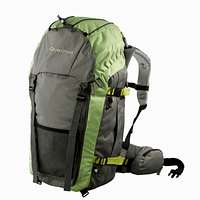Forclaz 60
Product Description
61 litres / 1.7 kg.Easy storage Pockets: 1 inner, 3 outer, 1 belt. Wide access to bottom of bag. Pole holder.
Anatomic design Adjustable back.
Efficiency Compression straps. Chest strap. Load adjuster straps. Thumb loops.
Moisture transfer Ventilated mesh back.
Features
How is the capacity of a pack measured? The capacity of every backpack is measured using a standard method: we fill the main compartment as well as every pocket with small balls. All the balls used are then emptied into a graduated container to measure the pack’s capacity in litres.How to pack a backpack. Put sleeping gear at the bottom. Position heavy items (tent, stove, food...) close to the back. Clothes are placed around these. The mattress goes under the hood and a tent can be fixed underneath the backpack if there is no more space inside. Make sure your wind jacket and fleece are easily accessible. Use the pockets to store small items (sun lotion, map, sunglasses,...) that will be needed during the day. Usually, there is a compartment along the back for a hydration pack.
How to fit a backpack. LOOSEN all the straps (shoulder straps, hip belt, tensioners). PUT THE BACKPACK ON. For backpacks with a capacity of 50L or more, PLACE THE HIP BELT CORRECTLY (over the hip bones) and FASTEN IT. For smaller backpacks, the hip belt should be placed around the waist. TIGHTEN THE SHOULDER STRAPS. Finally, ADJUST THE TENSIONERS to your personal requirements.
How to adjust the backpack’s back length Set the back length system as best you can and then fit the backpack (see the “How to fit a backpack” section). With the hip belt on the hips, the shoulder straps should cover the front area of your shoulders, and the tensioners (which are also sometimes adjustable in height) should be at a 45° angle (and not in a vertical or horizontal position). If you feel the back is too short or too long, restart the process until you feel comfortable.
Backpack technical tests. Backpack components are approved in laboratory tests: fabrics; buckles; straps; padding; zips... For example, fabrics are tested for resistance to abrasion, tearing, UV rays, repeated washing, waterproof properties, etc… A final test on the finished product simulates the kind of treatment to which it will be subjected over several years, to assess the strength of the assembly. A fully loaded backpack is put on a dummy to simulate the movements of a fast-walking hiker over thousands of cycles.



PAROFES - Jan 5, 2012 8:43 am - Voted 5/5
New on myIt fits just about all my mountaineering items with no problem.
Good pack.